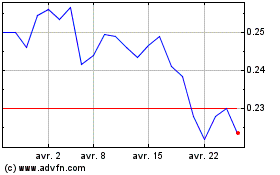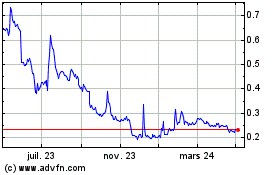Regulatory News:
SpineGuard (FR0011464452 – ALSGD) (Paris:ALSGD), an
innovative company that deploys its DSG (Dynamic Surgical Guidance)
sensing technology to secure and streamline the placement of bone
implants, announces the launch of a new three-year collaboration
program with two labs of Sorbonne University CNRS and Inserm: the
ISIR (Institute for intelligent systems and robotics) and LIB
(Laboratory for biomedical imaging).
DSG is based on the local measurement of electrical conductivity
of tissues in real time without X-ray imaging, with a sensor
located at the tip of the drilling instrument. Its efficacy was
proven by more than 90,000 surgeries across the globe and 19
scientific publications. SpineGuard has entered in 2017 a
collaboration with ISIR for the application of DSG to surgical
robots and the enhancement of their safety, accuracy, and
autonomy.
SpineGuard and ISIR capitalize on first order outcomes
published so far…
At the close of a first collaboration phase, SpineGuard
announced sub-millimetric accuracy experimental outcomes in bone
boundary detection and automatic stop of a vertebral drilling
performed by a robot using the DSG technology. These impressive
outcomes were presented as they were produced successively at the
Hamlyn medical robotics conference in London in May 2019, receiving
the first price for best scientific paper, then in plenary session
at the SMISS minimally invasive spine surgery (SMISS) in Las Vegas
in November 2021, and lastly during the CRAS conference in Naples
in April 2022.
… and join forces with the LIB laboratory in order to add
ultrasound to the project.
Encouraged by this success, the research and development teams
wish to go even further in surgical robots advancement: the
guidance technologies that allow the robot to position itself
properly relative to the patient to find the drilling entry point
rely today on X-Ray imaging, dangerous for health, in combination
with space-consuming optical registration. SpineGuard has long
explored the possibility to use ultrasound complementarily to DSG
for this preliminary step, before the tool is penetrating bone, and
was granted two families of international patents on that topic.
The LIB laboratory, who features an international level expertise
in the field of ultrasound imaging, answered with enthusiasm the
invitation to join the project. SpineGuard, ISIR and LIB thus start
a new 3-year collaboration that is expected to produce breakthrough
results in the field.
Stéphane Bette, co-founder and Deputy CEO of SpineGuard,
said: “We are happy to launch this partnership that will allow us
to go even further in improving surgical robots in orthopedics.
This new phase of the project aims at enabling robots to perform
bone drilling and cutting, as well as implant placement, in a
secured and more autonomous manner in the human skeleton. Our goal
is to implement first-class collaboration between French Research
and Industry and trigger commercial ventures in the orthopedic
field via strategic agreements with industry partners.”
Guillaume Morel, Professor at Sorbonne University and ISIR
Director, and Brahim Tamadazte, Researcher at CNRS and member of
ISIR, added: “We are delighted to continue the close and
dynamic collaboration initiated in 2017 with SpineGuard. The entry
of robotics and associated new technologies in operating room is no
doubt one of the biggest medical advances of the last twenty years.
Robotic approaches often allow the surgical gesture to be less
invasive, more accurate, safe and intuitive in numerous surgical
procedures. The first outcomes from the previous collaboration gave
us more visibility on the clinical added value that a robot with
original and effective sensors can bring to Orthopedic Surgery in
general and Spine in particular. This new collaboration will be
about ultrasonic sensors coupled with robotics. This original and
promising association will allow the surgeon to define the entry
point and the pedicle screw trajectory accurately and
non-invasively, without relying on ionizing or costly preoperative
imaging (scanner, MRI). The association of two prestigious labs of
Sorbonne University (ISIR and LIB), whose competencies are highly
complementary to SpineGuard’s industrial vision constitute a
stimulating work environment favorable to innovation. The journey
with SpineGuard goes on for three more years with a target of
several technologic and scientific innovations to serve patients
and care providers.”
Quentin Grimal, Professor at Sorbonne University and Manager
of the team “Ultrasound and imaging for bone quality
characterization” at LIB, concludes: “Using ultrasound to
position a surgical tool is particularly relevant. Ultrasounds are
danger free and provide real time information about interfaces,
bone anatomy, even bone mechanical quality. The use of an
ultrasound probe should allow to position the robotic arm in an
optimal manner to place pedicle screws. In general, echography does
not allow to see beyond the bone surfaces because ultrasounds are
strongly reflected at the surface and strongly attenuated when
propagating in bone. Low amplitude signals coming from inside bone
can however be exploited through specific treatments which are a
specialty of our team. Our team, pioneer in ultrasound utilization
to probe bone, has introduced several approaches that offer an
alternative to X-Rays for characterization of trabecular or
cortical bone health. For our team, this partnership with
SpineGuard and ISIR is a great fit: it will accelerate methodology
and instrument developments for a broader utilization of ultrasound
in orthopedic surgery. We are very happy to participate in this
innovation rich project.”
About SpineGuard®
Founded in 2009 in France and the USA by Pierre Jérôme and
Stéphane Bette, SpineGuard is an innovative company deploying its
proprietary radiation-free real time sensing technology DSG®
(Dynamic Surgical Guidance) to secure and streamline the placement
of implants in the skeleton. SpineGuard designs, develops and
markets medical devices that have been used in over 90,000 surgical
procedures worldwide. Nineteen studies published in peer-reviewed
scientific journals have demonstrated the multiple benefits DSG®
offers to patients, surgeons, surgical staff and hospitals.
Building on these strong fundamentals and several strategic
partnerships, SpineGuard has expanded the scope of its DSG®
technology in innovative applications such as the « smart » pedicle
screw, the DSG Connect visualization and registration interface,
dental implantology and surgical robotics. DSG® was co-invented by
Maurice Bourlion, Ph.D., Ciaran Bolger, M.D., Ph.D., and Alain
Vanquaethem, Biomedical Engineer. SpineGuard has engaged in
multiple ESG initiatives.
For further information, visit www.spineguard.com
About ISIR
ISIR is one of the largest French Research institutions in
robotics and intelligent systems, reporting mainly to Sorbonne
University, CNRS (National Center for Scientific Research) and
Inserm (National institute for health and medical research). It
regroups more than 50 teaching researchers and permanent
researchers and approximately 80 PhD ad post-doc students. ISIR is
structured around 6 research teams focused on artificial
intelligence and machine learning, mobile robotics, small scale
robotics, assistance robotics (physical therapy and mobility
support), human-robot interaction and surgical gesture assistance.
ISIR has a rich expertise in the design of innovative robotic
architectures, simulation and control, clinical validation and
transfer of high industrial potential results. Over the last 5 past
years, 10 pre-clinical or clinical studies were conducted at ISIR.
8 patents were granted, and 2 start-up companies created.
About LIB
The Laboratory for biomedical imaging (LIB) is specialized in
Fundamental and Applied Research for biomedical morphologic imaging
methods, functional and molecular on small animal and human. It
reports to Sorbonne University, CNRS and INSERM. It regroups 35
permanent researchers and teaching researchers, of whom half are
also hospital practitioners, approximately 10 engineers and
technicians and more than 30 PhD students and post-docs. LIB is
structured around 6 teams whose focuses correspond to key
priorities of 21st century Public Health: cancer, cardiovascular
and neurologic diseases, bone quality. LIB develops new diagnostic
and treatments methods exploiting various modalities: ultrasound,
MRI, CT, SPECT-PET, etc. LIB has a strong commitment to technology
transfer. Over the last 5 years, 6 patents were granted, 7 software
were filed, and 5 startup companies launched.
Disclaimer:
The SpineGuard securities may not be offered or sold in the
United States as they have not been and will not be registered
under the Securities Act or any United States state securities
laws, and SpineGuard does not intend to make a public offer of its
securities in the United States. This is an announcement and not a
prospectus, and the information contained herein does and shall not
constitute an offer to sell or the solicitation of an offer to buy,
nor shall there be any sale of the securities referred to herein in
the United States in which such offer, solicitation or sale would
be unlawful prior to registration or exemption from
registration.
View source
version on businesswire.com: https://www.businesswire.com/news/home/20220607006124/en/
SpineGuard Pierre Jérôme CEO & Chairman Tel: +33 1 45
18 45 19 p.jerome@spineguard.com
SpineGuard Manuel Lanfossi CFO Tel: +33 1 45 18 45 19
m.lanfossi@spineguard.com
NewCap Investor Relations & Financial Communication
Mathilde Bohin / Pierre Laurent Tel.: +33 1 44 71 94 94
spineguard@newcap.eu
Spineguard (EU:ALSGD)
Graphique Historique de l'Action
De Mar 2024 à Avr 2024

Spineguard (EU:ALSGD)
Graphique Historique de l'Action
De Avr 2023 à Avr 2024
